DNA
- Haplogroup X a Middle East and European DNA marker found in North America
- Haplogroup X in DNA distribution matches Hopewell and Book of Mormon migration, expanse and trade system
- Legend of Fu Sang Chinese knowledge of the North American continent
Haplogroups A, B, C, D, and X are found among the Indians of the American continents. Haplogroups A, B, C, and D can be explained as coming from Asia, but not haplogroup X, which is only found in North American Indians. Other North, Central, and South American Indians show the Haplogroups A, B, C, and D. Haplogroup X is not found in Asia, it is found in Israel, Europe and North America specifically the Great lakes region by New York State.
http://www.eupedia.com/europe/Haplogroup_X_mtDNA.shtml
https://en.wikipedia.org/wiki/Haplogroup_X_(mtDNA)
Scientists believe that haplogroup X crossed the Bering Ice Bridge sometime around 12000 and 30000 years ago. That belief is problematic because there is no DNA evidence trail that haplogroup X crossed the Bering land bridge. Applying the same reasoning that critics use to conclude that DNA disproves the Book of Mormon in Mesoamerica, you would also conclude that haplogroup X did not cross the Bering land bridge. There is no Native American haplogroup X DNA found in Siberia, East Asia, or the west coast of America, and it is completely absent in Central and South America. When looking at the haplogroup X DNA distribution map notice that it is not found in East Asia but in Europe and the Middle East. There is a small group of haplogroup X found in the Altaians of south Siberia but this subgroup of haplogroup X is not related to North American Indians and their arrival in the Altaians is after the Bering Ice Bridge would not have been crossable.
“Third, the few Altaian (Derenko et al. 2001) and Siberian haplogroup X lineages are not related to the Native American cluster, and they are more likely explained by recent gene flow from Europe or from West Asia”
Origin and Diffusion of mtDNA Haplogroup X
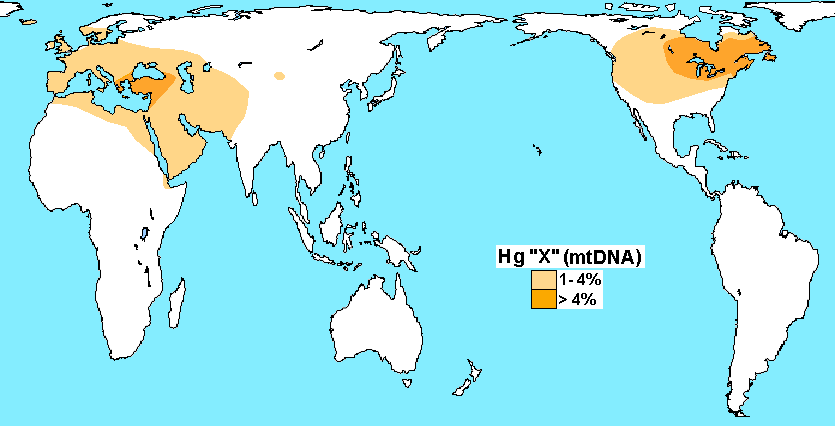
What also makes haplogroup X interesting is that it is a European. Caucasian DNA marker. The Caucasian part is important to keep that in mind as you read the quotes about Native American traditions and stories.
“Haplogroup X is remarkable in that it has not been found in Asians, including Siberians”
“In that case, as it has been proposed, haplogroup X was brought to America by the eastward migration of an ancestral white population, of which no trace has so far been found in the mtDNA gene pool of modern Siberian/eastern Asian population” (The Presence of Mitochondrial Haplogroup X in Altaians from South Siberia Am. J. Hum. Genet. 69:237–241, 2001)
“To date, haplogroup X has not been unambiguously identified in Asia, raising the possibility that some Native American founders were of Caucasian ancestry.”
“Overall, the sequence data and phylogenetic analysis suggest that the Native American and the European haplogroup X mtDNAs share a common maternal ancestor”
“The 14 Caucasian-European haplogroup X samples (designated “CE1”–“CE14”) included 2 Caucasians of European ancestry” (MtDNA haplogroup X: An Ancient Link between Europe/Western Asia and North America Michael D. Brown,1 Seyed H. Hosseini,1 Antonio Torroni,2 Hans-Ju¨rgenBandelt,3 Jon C. Allen,1 Theodore G. Schurr,1 Rosaria Scozzari,2 Fulvio Cruciani,2 and Douglas C. Wallace1)
“Phylogenetic analysis and coalescence estimates for American Indian and European haplogroup X mtDNAs exclude the possibility that the occurrence of haplogroup X in American Indians is due to recent European admixture.” (The Presence of Mitochondrial haplogroup X in Altaians from South Siberia Am. J. Hum. Genet. 69:237–241, 2001)
Nearly one-third of Native American genes come from west Eurasian peoples with ties to the Middle East and Europe (“Great Surprise”—Native Americans Have West Eurasian Origins http://news.nationalgeographic.com/news/2013/11/131120-science-native-american-people-migration-siberia-genetics/)
Another problem with the Bering Ice bridge theory is that Polynesian DNA is found in South America. The idea that Polynesians migrated across the Bering Ice Bridge is ridiculous.
“Researchers mapped similarities in genes, mutations and random pieces of DNA of Central and South American tribes with other groups. Warmer colors indicate the strongest affinities.”
(Pontus Skoglund, Harvard Medical School).
From the map below notice the lack of Asian pockets of DNA that correspond to South America in Siberia and East Asia. But the larger concentrations found in the tropical and warmer climates of South Asia. Why would any group of people migrate to the arctic subzero temperatures of Siberia and North East Asia from tropical and temperate climates? Comparatively very few people live in these arctic climates the reason why these locations are inhospitable to human life. There are large concentrations of the mentioned DNA found in South American but notice the particular DNA samples being shown as evidence is not found in what is now America and only one location in Canada. This evidence would suggest transoceanic voyages to South America. Below are quotes from articles and research papers questioning the Bering Ice bridge theory:
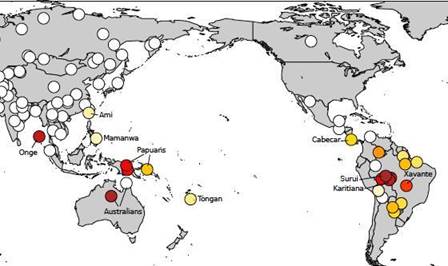
“The prevailing theory is that the first Americans arrived in a single wave, and all Native American populations today descend from this one group of adventurous founders. But now there’s a kink in that theory.”
“If Aleutian Islanders or their ancestors had somehow mixed with an Australasian group up north or made their way south to the Amazon, they’d leave genetic clues along the way. “It’s not a clear alternative,” argues Reich.”
“Three Amazonian groups—Suruí, Karitiana and Xavante—all had more in common with Australasians than any group in Siberia.”
“Both studies therefore suggest that the ancestry of the first Americans is a lot more complicated than scientists had envisioned.”
“There is a greater diversity of Native American founding populations than previously thought,” says Skoglund. “And these founding populations connect indigenous groups in far apart places of the world.”
Another valuable point in showing inconsistencies of the Bering land bridge theory is the Clovis/fluted spear point from Europe. This type of stone projectile is believed to have been brought from the European continent to North America via Bearing Ice Bridge. This spear point is found in Europe and North America but not found in Siberia or East Asia. How was this spear point brought to North America across the Bearing land bridge if it’s not found in Siberia and East Asia? Clovis spear points are found in plentiful supply east of the Rocky Mountains but in such areas as Alaska and the Aleutians where there should also be evidence showing this supposed crossing there are a few spots in Alaska most likely brought from movement from the east coast. But nothing in the way of evidence showing a land migration in Alaska or the Aleutians or East Asia or Siberia.
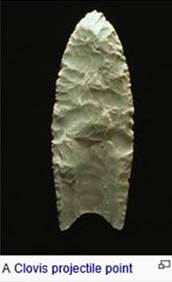
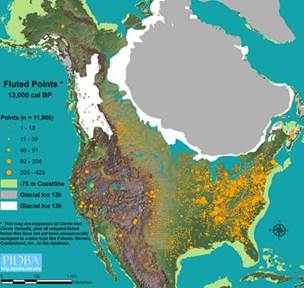
I believe it can be shown that haplogroup X and or the Jaredites are inexorably linked to this type of stone projectile. The Clovis people are believed to have caused the extinction of at least 25 genera of indigenous land mammals found in North America. To include horses, cattle, goats, and mammoths (elephants) all animals listed in the Book of Mormon. If the Jaredites brought over the Clovis spear point which I believe they did the Nephites and Lamanites eventually adopted this type of spear point. Major stumbling blocks to the historicity of the Book of Mormon can be shown to be false. I can only assume based on the evidence the current dating of the Clovis people is wrong and the Clovis point was used and arrived with the Jaredites. The current theory that this point arrived via the Bering land bridge without evidence proves this theory is in need of reexamination. That can be said of world migrations to the American continent also. The Clovis spear point map in my opinion is also indicative of the battles between Nephites and Lamanites fought in North America.
Originally the Bering Ice Bridge states that there was a single migration as far back as 30000 years ago. But population expansion of North America and diverse culture and linguistics populations found in North and South America prove against this. Now theorist are exploring the idea of two and maybe more migrations. I believe this is just the beginning of more theories to come. If attention can be turned to holes found in the Bering Ice Bridge theory I believe theories that include trans-oceanic voyages from Asia to the American continent will be unavoidable.
Scientists have used Anzick‑1 to show a genetic link between Siberia and North America, but there are a couple problems with this hypothesis. Anzwic‑1 is haplogroup D not X. It does not explain how haplogroup X arrived in North America. Based on genetic distribution haplogroup X and D, haplogroup X is more closely associated to the large concentration of Clovis and fluted points found on the east coast of America of which haplogroup D is almost completely absent from. Also, what would appear to be the founding populations based on the high concentrations of haplogroup D is found in central and South America – it’s not found on the west coast of North America or in Alaska. The physical evidence leads me to believe that haplogroup D arrived by trans-oceanic voyages to Central and South America.
“When Columbus reached the Americas in 1492, Native American occupation stretched from the Bering Strait to Tierra del Fuego, Torroni explained. Those native populations encompassed extraordinary linguistic and cultural diversity, which has fueled extensive debate among experts over their interrelationships and origins. “ (First Americans arrived as 2 separate migrations, according to new genetic evidence)
The DNA and Clovis spear points not found in Siberia and East Asia brings the bearing Ice bridge theory to a halt. But there is also a large amount of evidence disproving the timeline of a 15000BC to 30000BC timeline. The evidence will show there are certain North American Indian tribes that have Hebrew beliefs, linguistics, artifacts, technology and culture that date to biblical times and not to 15000BC which would predate these technologies and beliefs. A great example are the Hopewell and Adena Indians these cultures had an advanced metallurgy to include copper breastplates, copper and silver Jewelry, meteoric iron tools and weapons. The Hopewell and Adena had woven cloth and buttons. The Hopewell had an advanced trade system that stretched for thousands of miles with a highway system. It’s also worth noting that civilizations that had metallurgy, woven cloth and advanced trade system also had a written language. The oldest Hopewell archeological site is found in Florida at 500BC these Indians disappeared around 400 AD in the Great Lakes region. These technologies, cultural and linguistic ties show that haplogroup X arrived during biblical times by ship and not 12000BC to 30000BC through an arctic land migration.
The Hopewell Indians have haplogroup X DNA. The Adena culture end also matches the Book of Mormon. The Hopewell timeline geography and technology matches the Book of Mormon perfectly and makes them the perfect civilization to be the Nephites.
Haplogroup X DNA distribution is found on the east coast of America with the highest concentration found in the Great Lakes and Canada region. It’s not found in South and Central America and very little on the west coast of America. General world migration theory is that populations would follow the coast line we do not see this with haplogroup X. Scientist have point out dating of haplogroup X entry has been uncertain. Studies have shown population expansion of haplogroup X as stated by scientist happened during biblical times. One would assume that if haplogroup X arrived as late as 12000BC population expansion would have happened much earlier than what the current the evidence shows. Some scientist have theorized that haplogroup X crossed 3000 miles over ice from Europe to America across the Atlantic Ocean during the last ice. This theory is called the Solutrean theory and haplogroup X distribution and Clovis spear points are used as evidence. The theory that groups of people crossed over 3000 miles of frozen Atlantic Ocean ice is hard to swallow for the vast majority of scientist and this theory is not accepted. Any dating of haplogroup X by carbon dating past 6000 BC I believe is incorrect because of the evidence that will be provided and the environmental, uncertain atmospheric conditions of millennial dates, and variable inputs needed for carbon dating and biases of researchers.
The point of this is that theories of the populating of the American continent is fraught with holes. I believe DNA, cultural, and linguistic evidence will show that the American continent was populated through trans-oceanic voyages by ships versus land migrations in artic temperatures across barren ice. A view of geographical locations of South American DNA found in Asia has many locations in South Asia with fairly close proximity to the ocean suggesting ocean these voyages. The Book of Mormon states that there were three trans-oceanic migrations by ship, Lehi’s family, the Mulekites and the Jaredites. Polynesian DNA the legend of Fu sand and the Book of Mormon is all evidence that the Populating of North American was done by ship and not on artic land masses.
“The timing of initial entry into the Americas is uncertain. Through use of estimates of mtDNA diversity and rates of mtDNA evolution, a broad range of dates (11,000–43,000 years BP) have been estimated (Torroni et al. 1994; Bonatto and Salzano 1997a; Lorenz and Smith 1997; Stone and Stoneking 1998). Although researchers have recognized the need to incorporate population history in their estimates, the wide range of dates reported in the literature for the peopling of the Americas suggests that accurate models of Native American population history, accurate models of the evolution of mtDNA, and sufficient sampling of populations in the Americas have not yet emerged.”
http://www.ncbi.nlm.nih.gov/pmc/articles/PMC379119/
As will be shown in the essay North American Indians have beliefs that match the Book of Mormon perfectly. To include that Cherokee and Iroquois killed off a white race of Indian, certain Indian tribes sailed to North America and beliefs of written characters and letters. They had a lost gospel taken away from them, beliefs of a flood and Christ-like appearance. They also have Hebrew like language and culture and temple practices. Based on their own beliefs and traditions the Cherokee and Iroquois make up the primary tribes to be the Lamanites. The Micmac Indians based on the writings of Father Chretian Le Clercq are most likely to have been direct descendants of the Nephites.
Below I have added some quotes about Indian beliefs, culture and language. The quotes and evidence provided is a small sampling and just begins to scratch the surface out of the many books that have been written about the American Indians. To make the statement that there is no DNA, archeological, cultural and linguistic evidence to support the Book of Mormon is completely false the opposite is true. The quotes below come from today’s anthropologist. And the 19th 18th 17th century books are used by historians to write the history of the North American Indians. Some people might find using these sources as troublesome. But when it comes to exploring the beliefs culture and traditions of the American Indians the older the source the better due to the systematic destruction of the Native American way of life in the 18th, 19th and 20th century. One will also notice that statements made will be supported by multiple sources some from different countries and time spans.
Haplogroup X Distribution
Haplogroup X distribution matches the historical record given in the Book of Mormon and Bible. According to the Heartland Model Lehi and his family landed somewhere between the Florida Panhandle and Mississippi. Nephi and his family immediately separated from Laman and went into the wilderness. The Seed of Nephi would most likely be the Caucasian DNA marker of haplogroup X and Laman’s seed would have mixed with the Asian ethnic tribes of that area and era. In the Book of Mormon it states that the Nephites constantly had to move North because their traditional lands south were being over taken by the Lamanites. The Nephites also had an extensive trade system that included the use of horses and chariots. We can see from the map that haplogroup X reached to and beyond the Rocky Mountains. That matches the statements that Joseph Smith made about Zelph that he was known from the Rocky Mountains to the eastern see (Lake Ontario). If the Hopewell Indians are the Nephites we know that the extensive trade system of the Hopewell’s reached to the Rocky Mountains to Lake Ontario and beyond as shown in the haplogroup X map. Hagoth sailed across the West Sea with over 5000 men women and children and he made this voyage twice. The west sea is most likely Lake Michigan. Hagoth would have populated what is now Canada. Hagoth’s seed for the most part could have avoided the Nephite genocide which happened in the Great Lakes area and would account for the largest concentration of haplogroup X in Canada. I know that prophets and apostles made statements that Hagoth sailed to the Polynesian Islands. I believe this to be incorrect. I believe they made these statements based on opinion and the knowledge and accepted theories of that day. Prophets and apostles opinions have been wrong before about inconsequential and controversial topics such as the idea that blacks would never receive the Priesthood and that men lived on the moon.

As far as the Europe and Middle East distribution goes we know that Manasseh and his seed were in Egypt, Persia, and then went north to what is believed by traditional accounts of the Lost Ten Tribes moving north. Each geographical location mentioned in the Bible and Book of Mormon is accounted for from the origination point of haplogroup X and its move north into Europe. One research paper has pointed out that the Galilee Druze of Israel have the most diversity and the highest concentration of Haplogroup X found on the European and Eurasian continent.
“These Galilee Druze individuals represent the refugium of an ancestral group with high diversity and high frequency of haplogroup X, which was more prevalent in the region in antiquity, and from which the global diversity of X mtDNA haplogroup emerged.”
“We found that 39 of 41 haplogroup X Druze individuals were from the Galilee heights (Table S2), corresponding to 21.4% (39÷182) of the samples from that region. Enrichment analysis revealed that both X1 and X2 were highly enriched in this region”
The highest concentrations in the world of haplogroup X is found in the Israeli Galilee Druze at 27%. The North American Indians specifically the Ojibwa have the second highest concentration of haplo group x in the world. Haplogroup X is found in Europe in single digits. This match to the Bible and Book of Mormon is quite remarkable. If haplogroup X traveled with haplogroup A, B, C and D across Asia to North America, why do Ojibwa have the second highest concentration? It’s remarkable that a tribe in North America has almost the same concentration of haplogroup X in Israelis. This represents to me a recent and distinct voyage to the new world probably around 600BC. I believe it also shows that the Ojibwa in particular did not intermarry or populate with the other haplogroups already in the Americas. Haplogroup X is distinct from other haplogroups in every way.
The Book of Mormon points out two distinct civilizations that had metallurgy and woven cloth. The North American continent during the Book of Mormon timeline had two cultures and only two cultures that match this description: the Hopewell and Adena. The timeline given by the Book of Mormon matches the Hopewell culture and the end of the Adena culture. DNA distribution of the European and North American continent is also a match. There is absolutely no way that Joseph Smith could have known about the timelines and DNA distribution of these two cultures.
Asian Ethnic Tribes
The Asian ethnic tribes came from the west on the other hand the Great Lake Indians said they sailed here from another country to America from the east. “On the contrary, their traditions inform us that they came from the west that they crossed the Mississippi, and that they gradually travelled towards the east, “When you ask them,” says Lawson, speaking of the Carolina-Indians, ” whence their Fore-fathers came, that first inhabited the country, they will point to the Westward and say. Where the Sun sleep, our Fore-fathers came thence As far as my inquiries have extended, all the Indian nations on this side of the Mississippi assert, that they traveled from the west, from the northwest, or from the south. Many of them speak of their travel across the Mississippi. The Natchez informed Du Pratz, that before they came into the country east of the Mississippi, they dwelt nearly in the south-west, “under the sun” The Muskohge, or Creeks, assert that they crossed the Mississippi about the time that the army of Soto rambled through Florida. || The Chikkasah have told me, that they formerly lived to the west of the Mississippi and that they relinquished that country in obedience to a dream, in which they were advised to leave their western establishment and to go to the country where the sun rises.”
(Barton 1798 pg. XCII)
Fu Sang
How did the Asian ethnic tribes arrive in North America? A belief that they crossed the Bering ice bridge 30000 years ago goes against the idea that some believers hold that human life began with Adam and Eve 4000 years ago and against DNA evidence. I find the legend of Fu Sang an acceptable alternative vs the Bering land bridge theory. The legend of Fu Sang is that the Chinese sailed to America. The evidence used for this are Chinese style anchors found off the coast of California, legends describing gigantic trees (redwoods found in California) from a new land. Marco Polo is also used as evidence for Fu Sang. There is a 14th century goat skin map that shows what looks like the coast of Alaska what is believed to be passed down from Marco Polo to his posterity.
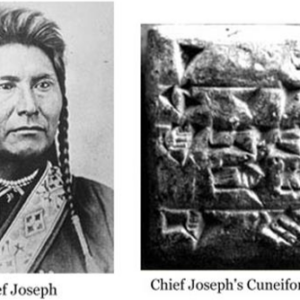
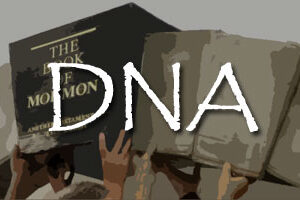

Leave a Reply